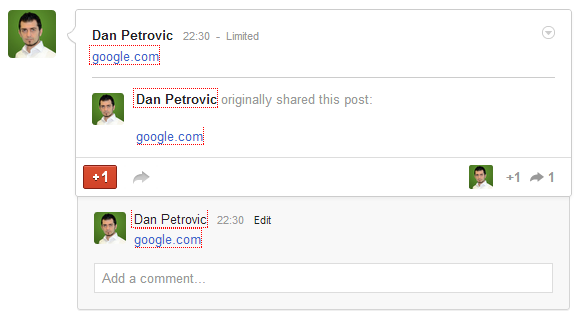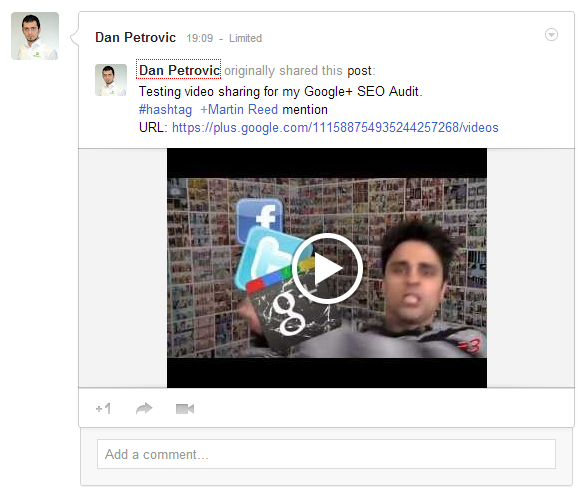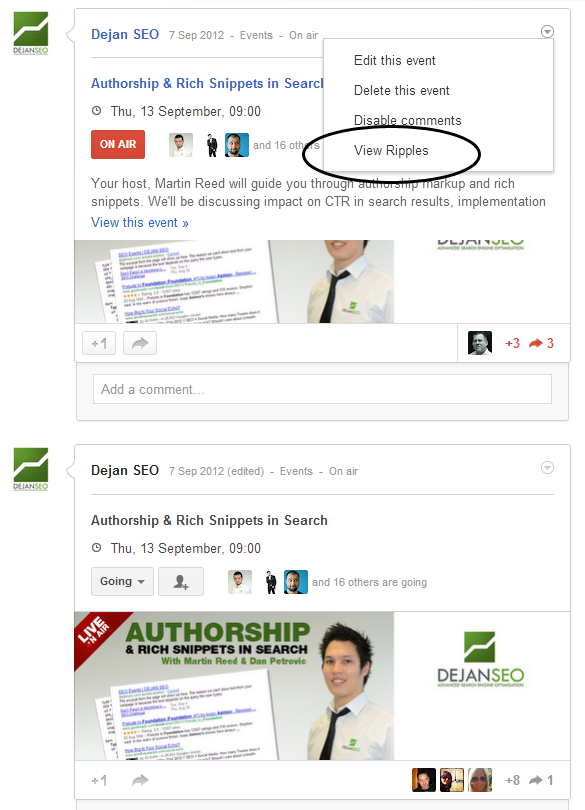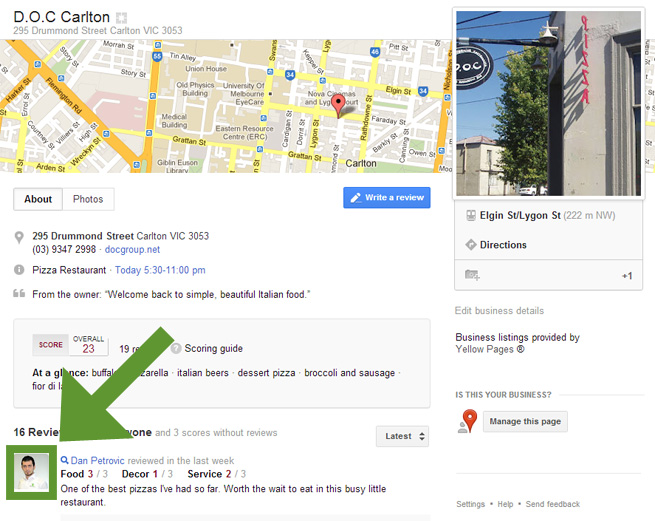Update: 8 January 2013
[styledbox type=”general” ]I’ve now covered the whole update in greater detail here: https://dejanmarketing.com/what-is-google-up-to-now/[/styledbox]
Somebody at Google has decided to use more rel=”nofollow” throughout Google+ and here’s an example:

URL within the post is nofollow, comment URL is nofollow, comment poster URL is nofollow (that was always like that) and the shared post URL is also nofollow.
Wow. OK, let’s switch to activity layer:

“+’ed” by is nofollow and reshared is nofollow. The question remains, what is follow?
The primary post URL is still followed. This makes sense as that’s typically a deliberate link topically related to the post and created by dropping the URL in the initial message field or using the link icon. One bit they missed in their anti-spam patch-up is the +mention as you can see in the example below:

Judging by the posts we analysed the update took place on the 5th of January 2013.
[styledbox type=”general” ]I’ve now covered the whole update in greater detail here: https://dejanmarketing.com/what-is-google-up-to-now/[/styledbox]
</EndOfUpdate>
Learn from the best they say, so I decided to run an SEO audit and analyse the architecture of Google+ to see if I can learn anything useful.

Canonicalisation
Google+ has a number of canonical issues and I will highlight one of them. On my posts page there are 11 instances of links to /u/0/
This causes everything to have two URLs with parameters which don’t change the content of the page. Something webmasters are advised to control through rel=”canonical” and/or parameter settings in Google Webmaster Tools.
Here’s an Example:
- https://plus.google.com/111588754935244257268/posts/NSUjfnLHt4E
- https://plus.google.com/u/0/111588754935244257268/posts/NSUjfnLHt4E
Their robots.txt file disallows /s/ which is related to search results, though these URLs can still appear in results, for example: https://plus.google.com/s/SEO appears in this search: https://www.google.com.au/search?q=site%3Ahttps%3A%2F%2Fplus.google.com%2Fs%2FSEO&pws=0

What’s amusing though is that anything that links to a noindexed directory goes in, even uppercase/lowercase variations as illustrated above.
Bonus: You can also change the 0 to 1 in the URL and double the canonical trouble visible in this search query:
site:https://plus.google.com/u/1/ | site:https://plus.google.com/u/0/
Coca-Cola:
- https://plus.google.com/+Coca-Cola
- https://plus.google.com/u/1/+Coca-Cola/posts (info: does not resolve)
- https://plus.google.com/u/0/+Coca-Cola/posts (info: does not resolve)
- https://plus.google.com/u/1/113050383214450284645 (info: resolves to the code based URL)
- https://plus.google.com/u/0/113050383214450284645 (info: resolves to customised URL)
UPDATE: Source code on /posts page contains <link rel=”canonical” href=”https://plus.google.com/+Coca-Cola“> and canonicalises to relevant pages on /about, /photos and /videos.
Unrelated to this audit, but still amusing, is that when you search for Coca-Cola you find Pepsi (who don’t even have their vanity URL yet):

What is interesting is that the “Co” in Pepsi’s page has been triggered as a relevant search term to “Coca Cola“. Why?
Reader Comments and Suggestions
W.E. Jonk
On canonicalisation you can also add the mobile site which has a disallow: m.google.com/app/plus
@dejanseo As far as i’m aware /u/0 and /u/1 are used to control which account you want to view if you’re logged into multiple G accounts.
— Mark Hannant (@tripleox) September 10, 2012
http://googlesystem.blogspot.co.uk/2010/08/google-multiple-sign-in-now-available.html
Well-spotted.
Duplicate Content & Hidden Links?
If you investigate links to my Google+ profile you will see the following list:

- Case 1: I +1’d Dan Russell’s post and my link is nofollow, I am not sure why this shows up in the link: if it’s not part of Google’s link graph. In any case I accept that there is a connection.
- Case 2: The hangout post links to my profile directly as I was one of the participants. No problems there.
- Case 3: This one was confusing as it had nothing to do with me. It’s a post about a car to which I did not engage in any way. What’s going on?
On closer inspection I found that the source code of the cached version of Lars Fosdal’s post also contains content from his recent posts and shares including one of my posts. What’s interesting is that the text-only version does not! Now all this wouldn’t be that unusual if it wasn’t for the fact that this content is not actually meant to be loaded and displayed. The link pointing to my profile is basically hidden in javascript googlebot has figured out not only how to get to the URL but the URL is also visible in the link: command.
Here’s how it looks like:
[“Dan Petrovic”,”111588754935244257268″,1,1,”https://lh5.googleusercontent.com/-c-qbWzoKUA0/AAAAAAAAAAI/AAAAAAAAAAA/MjzYOJzpxaI/photo.jpg”,”./111588754935244257268″]
So how’s this duplicate content? Well, if the same snippet is contained on a number of recent posts in addition to the posts page and the post URL itself we’re looking at more than 3, possibly 10-20 duplicated chunks of content. Now, clearly the ‘hidden links’ are not there for malicious or manipulative reasons so I’m letting Google of the hook for that one. At this stage I am more concerned about their content duplication issues.
Sitemaps
Google+ sitemaps have been broken up into small chunks ranging from 0 to 47,999 and referenced from the robots.txt as http://www.gstatic.com/s2/sitemaps/profiles-sitemap.xml
- http://www.gstatic.com/s2/sitemaps/sitemap-00000000.txt
- http://www.gstatic.com/s2/sitemaps/sitemap-00047999.txt
I am not sure about their scheduling but given the amount of new users joining their social platform one would expect fresher data:
<lastmod>2012-04-20</lastmod>
As you can see their last modified date is set to 20th of April 2012.
Another unusual thing is their referencing of URL pages:
- https://plus.google.com/115760104876378620585
- https://profiles.google.com/111586703185561240147
It could be that users with “profiles.” have not actually joined Google+ yet. I attempted to access the .profiles page with a plus. URL and noticed a neat 301 redirect back to the .profiles URL.
PageRank Sculpting
Google’s advice to webmasters is not to worry about PageRank sculpting and that using rel=”nofollow” on internal links is time wasted on something which could have produced better results, for example write good content or engage on social networks. What puzzles me is why Google+ then uses nofollow or many of their internal links and what exactly they are trying to achieve with that.
This is my question for Matt Cutts, if you’d like it answered please vote for it on Google Moderator:
Google+ is using rel=”nofollow” on some of its internal links. Why?
Link: http://goo.gl/mod/6vzQ
“Sometimes we try to be cautious, just so we don’t become any sort of spam attack vector ourselves. Over time, as we come up with ways to make sure that things are spam-resistant, we might remove that nofollow attribute though.” Matt Cutts, Mountain View
Although I do appreciate the answer I still don’t understand how this would help since they’re not using nofollow on external links and using it on only selected internal links. It just doesn’t strike me as an anti-spam prevention measure.
I started mapping the architecture of Google+ in order to understand why they did this and have initially come up with a few modes of various entities and actions on their social network:
Activity |
Item |
Ownership |
| Plus | Image | Own |
| Share | Video | 3rd Party |
| Mention | Post | |
| Hashtag | Comment | |
| Tag | Event | |
| Comment | Page | |
| Add | Userpage | |
| Invite | Circle | |
| Review | URL | |
| Place | ||
| Hangout |
In the next stage I started mapping various scenarios starting with posts, both original and shared.
Posts
When you create your own post links will flow naturally unobstructed by nofollow, however when people comment, +1 or share your post, link to their profile will be nofollowed. This applies to both users and pages. Exception to the nofollow rule are +Mentions which flow naturally as well as any links shared in post comments, including links to external sites which is odd. It seems Google is not afraid of linking out and counting on the post author to moderate.
Shared Posts
Shared posts operate similar to original posts except that the original author’s profile link gets a nofollow. Why? To be fair the link to the original post is a dofollow.
Photos
Photos and images have two distinct modes. They can appear in context of a post (either as tagged, original and shared) and as a gallery item. Tagged people are nofollowed in the post mode, but like most other things are dofollow in the gallery mode. In gallery mode live links to external links are not possible. Pasting a URL in the gallery-mode comments will simply display it as text and not include the hyperlink.
Examples:
- Gallery Page: https://plus.google.com/photos/106901586566350117179/albums/5534350902409677473
- Gallery Image: https://plus.google.com/photos/106901586566350117179/albums/5534350902409677473/5619813418937964802
- Image Share Post: https://plus.google.com/111588754935244257268/posts/JpSWtTDbiNT
Videos
Essentially the same thing as photos, in both shared post and gallery mode. Shared author gets a nofollow, original post is followed, hashtags, +Mentions and live links are also followed.

In the gallery mode for this video URLs are not hyperlinked and everything that is linked up is dofollow.
Comments
As you’ve already seen from examples above, comment authors are followed links only in media pages (images, videos) in gallery mode. Everywhere else they’re nofollowed. Comment +Mentions and URL do not contain nofollow.
Events
Events are nofollow free, posts, comments, mentions – the works. Here’s an example.
One thing that confuses me about event posts is the two similar post types created with the event. One is supposed to be an actual post (it contains ripples option, event description and the “on air” button) and the other one is the event itself in form of a post where people can interact (RSVP) their attendance and invite others.

Followed links on event posts (apart from the usual ones) are selected three who have set their attendance to “Going”. Neither of them have a post URL you can easily grab as you would with everything else by clicking on the post date. Instead the URL is available once the event post is re-shared. How strange!
Here you can see examples of shared event and event post which now have available URL:
- Shared Event: https://plus.google.com/111588754935244257268/posts/cxgYrAHadMD (only visible to my extended circles, you’ll have to add me to see it)
- Shared Event Post: https://plus.google.com/111588754935244257268/posts/My9vQhzr7eA (available publicly)
Note that one of them doesn’t have the original “post” link reference whereas the other links to the event page instead.
Hangouts
Hangout participants listed on a public post are all followed profile links:

Circles
Links to people in shared circles are nofollow:

Pages & User Profiles
There are three key areas I observed with pages and user profiles on Google+. First one is the fact that the tabs: posts, about, photos, videos…etc basically all represent one page cached in Google and almost simulate URLs for the purpose of usability.

Basically, what I’m saying is that at least two of the above URLs in orange are essentially the same page in Google’s cache (posts and about). Further to that the followers and following segments (in red) doesn’t seem to be in cache nor source code so this means that adding people for the purpose of manipulating PageRank will not work. Finally the page’s official URL (in green) is an enabled link which makes sense.
Reader Observations
Place Page
Engagement on the place page is rewarded by a dofollow link for reviewers who have a Google+ profile activated. The rest are not hyperlinked.

This article may be updated again soon.
Drop me a line if you find something interesting and I’ll add you as the article contributor.
Dan Petrovic, the managing director of DEJAN, is Australia’s best-known name in the field of search engine optimisation. Dan is a web author, innovator and a highly regarded search industry event speaker.
ORCID iD: https://orcid.org/0000-0002-6886-3211




Great Stuff. Thanks Dan!
Thank you Dan for this analysis. Even if links are nofollow, I consider a link is a link so it adds value. And i am sure Google will strongly consider links and commentary activites on Google + 🙂
Nice to see someone go to the effort adn provide the detail/examples,
good job that man!
Google has a ton of Canonical Issues – most of their forums are available under various addresses.
I think many of their other products/platforms have similar issues as well.
Some canonical issues are a nightmare to handle.
Others though should be simple fixes … so no idea why G have never really tackled them.
Hi!
Wow, one of the best articles I’ve ever read! A lot of works behind and thank you very much for sharing it! 🙂 bye!
While sharing photos , posts or videos on google plus I always think whether it will generate a no follow link or a do follow link but after reading your post my concept is little bit clear in this regard. As social media play a very crucial role in SEO and now its the time to focus on the social media aspects to achieve high ranking.